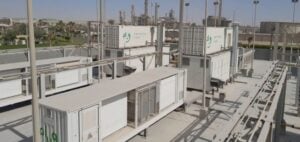From Andalusia to the Basque Country,green hydrogen megaprojects are multiplying in Spain, a leading country in this promising sector. A gamble, while the economic model of this energy of the future has yet to be found. “Everything is going very fast… There are so many initiatives that it is impossible to list them all,” says Miguel Angel Fernandez, director of the National Hydrogen Center (CNH2), a public research organization based in Puertollano (center).
It is in this former mining town, surrounded by mountains, that the energy giant Iberdrola started up a pilot site last summer, presented as the largest European green hydrogen production plant for industrial use in operation. Once the test phase is completed, the tall white tanks of this pioneering installation, linked to a 100-megawatt photovoltaic park, should supply 10% of the annual needs of the neighboring factory of fertilizer giant Fertiberia, or 3,000 tons of hydrogen. This will avoid the emission of 48,000 tons of CO2 per year, according to Iberdrola, which wants to test its large-scale production capacity on this site.
“If the project works, we will launch a second, much larger phase” to provide “100%” of the fertilizer plant’s needs, before extending this model to other Fertiberia plants, says Javier Plaza, head of green hydrogen at Iberdrola.
“Effervescence”
Cepsa, Naturgy, Repsol… In the wake of Iberdrola, a number of Spanish energy heavyweights have launched themselves in recent months into the race for green hydrogen, produced from renewable electricity – and not from fossil fuels, as is the case for “grey” hydrogen.
In Andalusia (south), three billion euros will be invested in the “Andalusian Green Hydrogen Valley”, an industrial complex with two giant plants capable of producing 300,000 tons of this gas, which releases only water vapor when burned, and on which many are betting to decarbonize transportation and industry.
In the Basque Country (north), 1.4 billion euros are to be spent on a project involving some 60 companies. And in Asturias (north), 15 photovoltaic parks will be built by 2030, with a production capacity of 330,000 tons of hydrogen. “There is currently an effervescence”, which places Spain “in a leading position” in the sector, underlines Rafael Cossent, researcher at the Pontificia Comillas University in Madrid. A position linked, according to him, to its enormous resources in solar and wind energy.
Spain has the potential to “produce renewable hydrogen in large quantities, not only for its own needs, but also to export it to northern Europe,” says the Spanish Hydrogen Association (AeH2), which mentions nearly “50 projects” in progress. In its roadmap approved in 2021, the Spanish government had thus foreseen four gigawatts of installed capacity by 2030. However, in view of the announcements of recent months, “we will reach 14 or 15” gigawatts, estimates Miguel Angel Fernandez.
Pipeline to France
For Spain, however, this acceleration is a gamble. Green hydrogen, which is currently more expensive to produce than grey hydrogen, has not yet demonstrated its economic viability, even if the gradual decrease in costs is giving the sector cause for optimism. For Rafael Cossent, the generalization of its use also implies “complex transformations” of vehicles or industrial installations, which make the hydrogen market uncertain at this stage, due to the lack of adequacy between supply and demand.
“We cannot afford an oversizing” of the offer that because of the costs involved would lead to “a loss of competitiveness of our entire industry”, warned in January the president of the Spanish competition authority Cani Fernandez. To guarantee outlets for its production, Madrid is counting on the future undersea pipeline between Barcelona and Marseille (H2Med), which should make it possible to transport two million tons of hydrogen per year by 2030.
However, this project faces a series of obstacles linked in particular to the nature of hydrogen, made up of small aggressive molecules that are difficult to transport, which cast doubt on the deadlines set for its completion. Difficulties of which the giants of the sector say they are aware. “We’re talking about a long-term race,” explains Javier Plaza, from Iberdrola, who believes that, despite the risks, it is important to start now because “the one who starts first has the advantage.






















